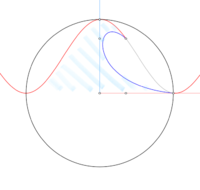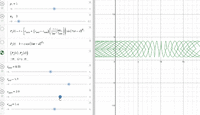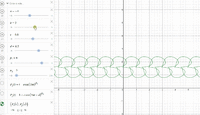Hey everybody,
As a personal challenge, I want to graph (ocean) waves in stylized, somewhat artistic way and thus better understand the maths begind it.
I started by plotting [MATH](t-sin(t)a, 1+cos(t)b)[/MATH]. Cool, that's a classic "garland".

And now it gets interesting: Well, how about barrel waves? What should I be looking at to make the peaks curl without looping over themselves? How would one 'scale' or 'skew' (for lack of terminology) the garland shape along x?
I can visualize what i'm after, i can't express it in maths terms. Any suggestions?
My intuition is that I need a funtion for the blue line below and then...with my math level, things become quite fuzzy here, do something to the sine wave. Done. )
)


Help point me in the right direction, anybody?
Cheers!
As a personal challenge, I want to graph (ocean) waves in stylized, somewhat artistic way and thus better understand the maths begind it.
I started by plotting [MATH](t-sin(t)a, 1+cos(t)b)[/MATH]. Cool, that's a classic "garland".

And now it gets interesting: Well, how about barrel waves? What should I be looking at to make the peaks curl without looping over themselves? How would one 'scale' or 'skew' (for lack of terminology) the garland shape along x?
I can visualize what i'm after, i can't express it in maths terms. Any suggestions?
My intuition is that I need a funtion for the blue line below and then...with my math level, things become quite fuzzy here, do something to the sine wave. Done.

Help point me in the right direction, anybody?
Cheers!






